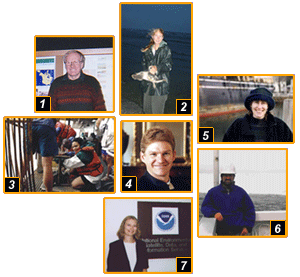 | In this Section: | |  | In the Spotlight |  | News |  |
List of "In the Spotlight" Features
Get to Know the Signals of Spring Scientists

|
It is that time of year. The birds are flying, and Signals of Spring students are analyzing their every move. When students work, Signals scientists work as well. After students post an analysis journal online, scientists from all over the country may have a chance to read and comment on it. Our scientists, who are experts in diverse areas of science, help students to make connections and develop their ideas. This interaction between scientists and students is one of the most unique and exciting parts of the Signals of Spring program.
Signals of Spring scientists have a wide range of backgrounds and research interests, you can read all of their biographies by clicking here. Like Signals students, the scientists’ areas of expertise include biology (bird and marine species), plants and forestry (vegetation), weather and climate, geology and geography, sea surface conditions, phytoplankton, and bathymetry. For example, scientists Dr. Gary Krapu (1), of USGS, studies bird migrations, particularly in raptors, and Catherine McClellan (2) of the Duke University Marine Lab, studies sea turtle and fish movements.
However, as Signals students should discover, science does not come in separate packages, all the study areas are interconnected. Dr. Ashanti Johnson Pyrtle (3), Georgia Institute of Technology, for instance, combines the areas of oceanography and environmental science as she studies how pollutants are transported. Dr. Raphael Kudela (4), of USC at Santa Cruz, links physical and biological sciences by studying light and phytoplankton. Drs. Donna Witter (5) and Joe Ortiz (6) of Kent State University combine the Atmospheric and Oceonographic Sciences to study circulation and past climate.
Every year, Signals students are excited when scientists comment on their journal entries. Our scientists often answer student questions, and pose new ones for students to consider. Some classes even have contests to see whose journals are rated “excellent” by a scientist!
While student/scientist interaction is important to students, scientists also find it critical. Ingrid Guch (7), of NOAA, highlights the significance of students making connections as she explains, “In the Signals of Spring program I see students doing important work. They are beginning to discover how to observe the Earth and how to identify the relationships between what is going on over the land, oceans, atmosphere and biosphere.” In addition, Ingrid believes that studying animals through Signals of Spring will help students throughout their lives by giving them, “the scientific and critical thinking skills they will need to meet the
complex environmental challenges of the future.”
Look for scientist comments on your journals, and keep your eye out for new scientist partners within the next few weeks!
|
